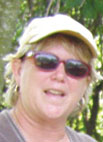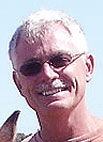
"I never knew I was an outdoors-type person,” Jamie Haase said, smiling from the seat of her beat-up Ford farm truck. After years in the Extension office in McDonald County, Jamie realized that a full-time job at the farm was the ideal place for her.
On about 350 acres near Stella, Mo., Jamie found a passion for developing and raising cattle. “We sell off the farm, private treaty,” Jamie said. “I’m not really good at selling myself. It’s a man’s world. But I’m getting more assertive.” Her marketing technique now? “I tell people, this is what they are, I’m not making any excuses.”
Jamie has taken a “breed it on rather than feed it on” approach with her animals.
“My bulls may not weigh what some others weigh, but they won’t fall apart,” she said. Focusing on fleshing and muscling, but demanding low birth weights, Jamie said you can have the best of both worlds, if you’re careful.
Jamie’s Maine-Anjou and Angus bulls are fed a cheap feed and are grazed on the local fare her pastures offer, which is a mix of fescue, legumes and natives like big bluestem.
She crosses her Angus and Maine-Anjous to make what is recognized as the Mainetainer crossbreed that she is very happy with.
The Mainetainers
Maine Anjou used to be known for massive birth weights, Jamie noted, which makes a lot of people afraid of them. “They don’t realize how many more pounds a Maine Anjou can wean, and there are low-birth weight Maines out there.” Jamie has had great success with her Mainetainers; her Maine Anjou bull produced 65 to 75 lb. mainetainer calves. “And then those bull calves wean off at 40 to 50 lbs. more than a straight Angus,” she noted. The Maine Anjou herd bull will also put more muscle on the calves, Jamie said, but she has not seen the double muscling people are afraid of with the Maines.
“The Mainetainers are excellent cows, excellent mothers. The Angus puts more milk in the mix and the Maine Anjou puts the thickness and depth of body on.”
Jamie’s family is very active on the farm with her. She’s quick to point out, “I couldn’t do this without my dad. My brothers help me out, too."
Jamie’s husband, Don, is a big part of the farming operation when he’s not busy with his construction business. Jamie manages the books for her husband’s business, but has many other daily responsibilities, like milking the family dairy cow (Jamie’s mother has made over 75 lbs. of cheddar cheese so far.), and feeding over 100 head of cattle, when they’re not grazing on the predominately native grasses that fill the Hasse’s pastures.
Right now, Jamie and her dad, Jim Dumond, are trying their hand at putting up hay. In the past they have just purchased hay, but they are planning to use hay they are harvesting off their land, with some forages they are stockpiling, to get them through the winter.
Artificial Insemination
Jamie artificially inseminated 70 cows this spring. After attending AI school in 2003, she has really put the technology to use, although she admits at first she AI-ed at her farm solely because she had spent the money and she didn’t want it to be a waste. As time went on, and she became better at AI, she began to appreciate all it could offer a small producer like herself.
“I study the catalogs. My kids make fun of me because I get so excited when a new catalog comes in,” she smiled. But the research pays off when she sees the kind of calves she wants to see.
Right now Jamie plans to improve her operation by getting back into using CIDRs for heat synchronization. “I think you get the best conception rates with natural heat." she said. But, with the growing size of her herd, natural heat detection isn’t effective, anymore, she explained.
Aside from the challenges, Jamie was quick to point out her favorite part of the artificial insemination process. “The calving. It’s just like Christmas,” she smiled.







